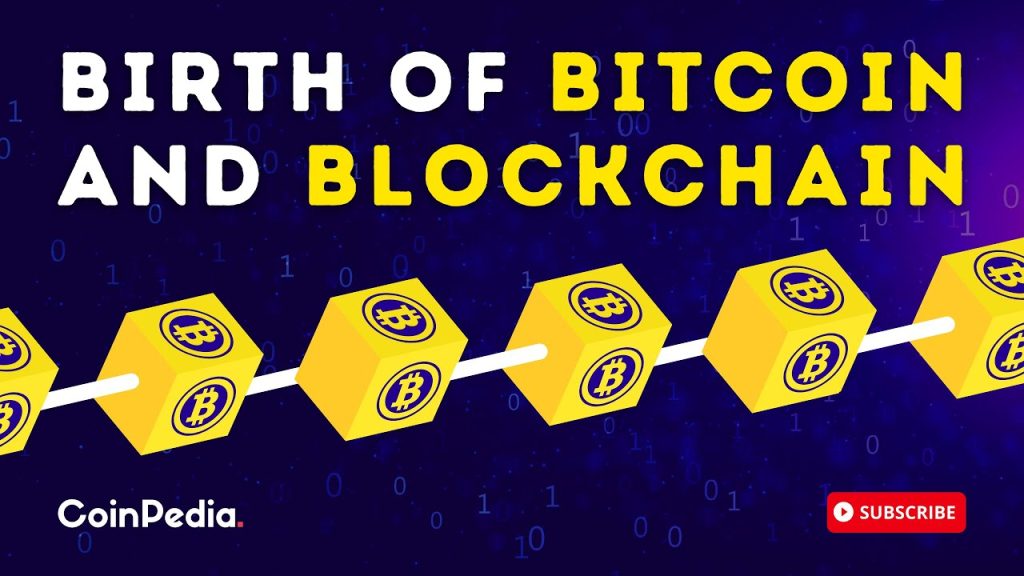
The post The Birth of Bitcoin: A Game-Changer for The Global Economy appeared first on Coinpedia Fintech News
In the year 2008, the world was in the midst of a financial crisis.
Banks were failing left and right, and governments scrambled to bail them out. The headline of the newspaper read “Chancellor on brink of second bailout for banks.”
Amidst this chaos, a person or group of people using the pseudonym Satoshi Nakamoto began to work on a revolutionary idea. They discovered the concept of “Proof of Work” (PoW) which would allow for a decentralized digital ledger of transactions.
“Satoshi, who remains anonymous to this day, began working on the idea for Bitcoin in 2007.”
In this article, we’re dwelling on the exciting world of Bitcoin and exploring its origins. From its mysterious creator, Satoshi Nakamoto, to the early days of mining and trading, we’ll be taking a closer look at how this revolutionary digital currency came to be.
The Origins of Bitcoin
Satoshi Nakamoto is the pseudonym used by the anonymous creator(s) of Bitcoin and the original author of the Bitcoin white paper, which was released in 2008. Despite being widely known as the creator of Bitcoin, Satoshi Nakamoto’s true identity remains unknown.
Satoshi Nakamoto’s contributions to the development of Bitcoin and blockchain technology are significant.
The Bitcoin white paper proposed a decentralized peer-to-peer electronic cash system that would allow for secure and anonymous transactions without the need for intermediaries like banks or payment processors.
This was achieved through the use of blockchain technology, a distributed ledger system that allows for secure and transparent record-keeping. He wanted to create a decentralized digital currency that would allow for peer-to-peer transactions without the need for a central authority.
Today, Bitcoin is the world’s largest cryptocurrency by market capitalization and has spawned a wide range of other cryptocurrencies and blockchain-based applications.
The Key Concepts of Bitcoin
Bitcoin is built on several core concepts that distinguish it from traditional currencies and payment systems. Decentralization is one of the key principles of Bitcoin, meaning that the network operates without a central authority or intermediary.
Instead, transactions are verified and recorded by a distributed network of nodes, which use cryptography to secure the network and ensure the integrity of transactions. Blockchain technology is another fundamental concept of Bitcoin, providing a transparent and tamper-proof record of all transactions on the network.
Finally, the concept of mining is central to the creation of new bitcoins, with users contributing computing power to solve complex mathematical problems and earn rewards in the form of new bitcoins.
In October 2008, Nakamoto released a white paper detailing the concept of Bitcoin, an electronic cash system that would use PoW to control the creation and transactions of a digital currency.
On 1st November 2008, Satoshi wrote an email to a cryptography mailing list, sharing the details of this new system. He also shared a link to the technical paper he had written, which is still available today.
Eventually, he believed that the traditional financial system was flawed and that a decentralized currency would be a fairer and more efficient way of conducting transactions. Since then, the development of Bitcoin and blockchain technology has been carried on by a community of developers and enthusiasts.
He explained that this new system would be completely decentralized, meaning that the users wouldn’t have to rely on a central authority for monetary transactions. He also expressed dissatisfaction with traditional central banks and their history of breaches of trust.
Early Adoption and Growth of Bitcoin
In the early days of Bitcoin, the digital currency was mostly used by a small group of enthusiasts and early adopters. However, as the value of Bitcoin began to rise and more people became aware of its potential, a growing number of merchants and businesses began to accept it as a form of payment.
The creation of the first Bitcoin exchanges also made it easier for people to buy and sell bitcoins, helping to fuel the growth of the network.
A couple of months later, On January 3rd, 2009, Nakamoto mined the first block of the Bitcoin blockchain, known as the Genesis Block. This marked the birth of Bitcoin and was accompanied by a message in the Genesis Block.
“Satoshi created 50 Bitcoins with the very first transaction on the blockchain.”
This marked the birth of Bitcoin, a revolutionary new kind of money that would allow for secure and transparent transactions without the need for intermediaries. The transaction also had an embedded message, including a timestamp, that indicated the Bitcoin founder’s possible nudge to finally make Bitcoin live.
The message read “The Times 03/Jan/2009 Chancellor on brink of second bailout for banks” referring to the headline of a news article that appeared that day in The Times in the UK that talked about a second bailout for the banks.
Satoshi’s Creation of the BitcoinTalk Forum
To spread the word about this new currency, Nakamoto created the BitcoinTalk forum, where people could discuss and learn about Bitcoin.
He also created a website with the domain name bitcoin.org and continued to work on the bitcoin software.
Throughout 2010, Satoshi Nakamoto collaborated with other developers to modify the bitcoin protocol. He was actively involved in the bitcoin community and corresponded with them frequently.
But then, all of a sudden, he gave the keys and codes to Gavin Andresen and transferred domains to members of the community.
By the end of 2010, he had stopped working on the project.
Years went by, and the community wondered about the whereabouts of the mysterious Satoshi Nakamoto.
But on Saturday, April 23, 2011, the creator of bitcoin emerged once again to post his last message. When developer Mike Hearn asked him if he planned to rejoin the community,
Satoshi replied:
“I’ve moved on to other things. It’s in good hands with Gavin and everyone.”
And with that, Satoshi Nakamoto disappeared from the public eye, leaving behind a revolutionary new kind of money that would change the world forever. Despite the significance of Satoshi’s role in the birth and development of Bitcoin, its true identity remains a mystery.
Many theories have been put forward as to who Satoshi might be, with some speculating that they are a group of people and others believing that they are a lone individual.
Challenges and Controversies
Despite its many advantages, Bitcoin has faced its fair share of challenges and controversies over the years. One of the most notable controversies was the Silk Road scandal, in which Bitcoin was used to facilitate illegal activities on a darknet marketplace.
This incident tarnished Bitcoin’s reputation and raised questions about its potential as a legitimate currency.
In addition, regulatory challenges have been a constant issue for Bitcoin, with many governments and financial institutions expressing skepticism about the digital currency and its potential impact on the global financial system.
Current State of Bitcoin
Today, Bitcoin is the world’s largest cryptocurrency by market capitalization, with a growing number of merchants and businesses accepting it as a form of payment.
The emergence of other cryptocurrencies and blockchain-based applications has also fueled the growth of the broader blockchain industry, with many experts predicting that blockchain technology will transform many aspects of our lives in the years to come.
However, Bitcoin also faces ongoing regulatory challenges and skepticism from some governments and financial institutions. Some countries have banned or restricted the use of cryptocurrencies, while others are taking a more cautious approach to their regulation.
Overall, the current state of Bitcoin is one of growth and increasing mainstream acceptance, but also one of ongoing challenges and uncertainty. As with any emerging technology, it will be fascinating to see how Bitcoin and the broader blockchain industry continue to evolve in the years to come.
Conclusion
The birth of Bitcoin was a watershed moment in the history of finance and technology, paving the way for a new era of decentralized innovation and disrupting the traditional banking system.
While Bitcoin has faced its fair share of challenges and controversies over the years, its impact on the world of finance and technology cannot be ignored.
As we move into the future, it will be fascinating to see how Bitcoin and other blockchain-based applications continue to evolve and shape our world. I hope you might have learned a lot more about the Birth of bitcoin and its creator.

 2 years ago
138
2 years ago
138














 English (US) ·
English (US) ·